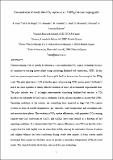Por favor, use este identificador para citar o enlazar a este item:
http://hdl.handle.net/10261/87635COMPARTIR / EXPORTAR:
 SHARE SHARE
 CORE
BASE CORE
BASE
|
|
| Visualizar otros formatos: MARC | Dublin Core | RDF | ORE | MODS | METS | DIDL | DATACITE | |

| Título: | Demonstration of steady state CO2 capture in a 1.7 MWth Calcium looping pilot |
Autor: | Arias Rozada, Borja CSIC ORCID ; Diego de Paz, María Elena CSIC ORCID ; Abanades García, Juan Carlos CSIC ORCID ; Lorenzo, M.; Díaz, L.; Martínez, D. CSIC; Sánchez Biezma, A. | Palabras clave: | CO2 capture Calcium looping Pilot testing |
Fecha de publicación: | oct-2013 | Editor: | Elsevier | Citación: | International Journal of Greenhouse Gas Control 18: 237-245 (2013) | Resumen: | [EN]Calcium looping, CaL, is rapidly developing as a postcombustion CO2 capture technology because its similarity to existing power plants using circulating fluidized bed combustors, CFBC. In this work we present experimental results from a pilot built to demonstrate the concept at the MWth scale. The pilot plant treats 1/150 of the flue gases of an existing CFBC power plant (“la Pereda”) and it has been operated in steady state for hundreds of hours of accumulated experimental time. The pilot includes two 15 m height interconnected circulating fluidized bed reactors: a CO2 absorber (or carbonator of CaO) and a continuous CaCO3 calciner operated as an oxy-fuel CFBC. Operating conditions in the reactors are resembling those expected in large CaL CO2 capture systems in terms of reactor temperatures, gas velocities, solid compositions and circulation rates and reaction atmospheres. The evolution of CO2 capture efficiencies and solid properties (CO2 carrying capacity and CaO conversion to CaCO3 and CaSO4) have been studied as a function of key operating conditions. It is demonstrated that CO2 capture efficiencies over 90% are feasible with a supply of active CaO slightly over the molar flow of CO2 entering the carbonator. Closure of carbon and sulphur balances has been satisfactory during steady state periods. A basic reactor model developed from smaller test facilities seems to provide a reasonable interpretation of the observed trends. This should facilitate the further scale up of this new technology. | Versión del editor: | http://dx.doi.org/10.1016/j.ijggc.2013.07.014 | URI: | http://hdl.handle.net/10261/87635 | DOI: | 10.1016/j.ijggc.2013.07.014 | ISSN: | 1750-5836 |
| Aparece en las colecciones: | (INCAR) Artículos |
Ficheros en este ítem:
| Fichero | Descripción | Tamaño | Formato | |
|---|---|---|---|---|
| Demonstration of steady state _Arias.pdf | 340,76 kB | Adobe PDF |  Visualizar/Abrir |
CORE Recommender
SCOPUSTM
Citations
282
checked on 13-abr-2024
WEB OF SCIENCETM
Citations
250
checked on 24-feb-2024
Page view(s)
510
checked on 22-abr-2024
Download(s)
694
checked on 22-abr-2024
Google ScholarTM
Check
Altmetric
Altmetric
NOTA: Los ítems de Digital.CSIC están protegidos por copyright, con todos los derechos reservados, a menos que se indique lo contrario.
